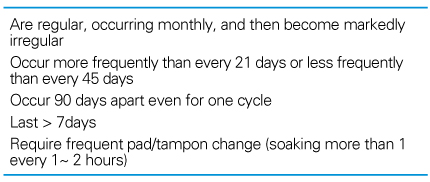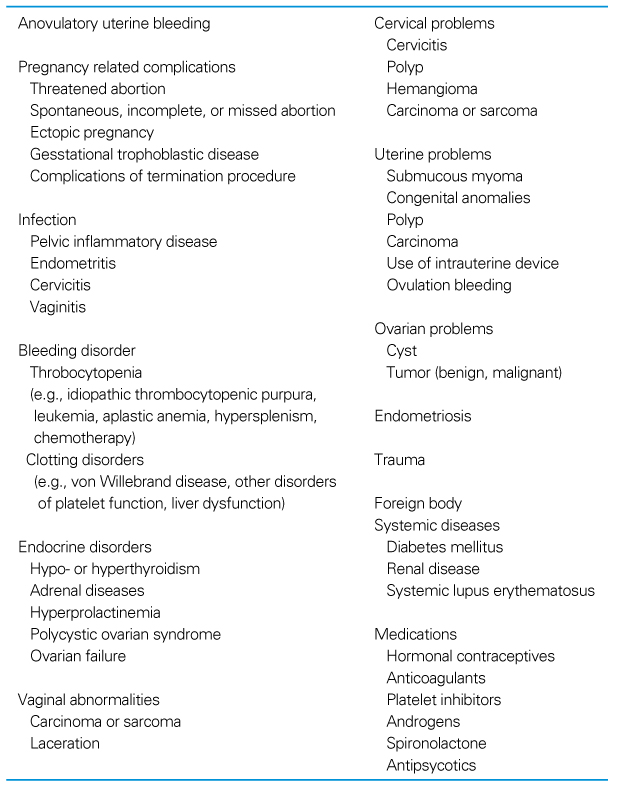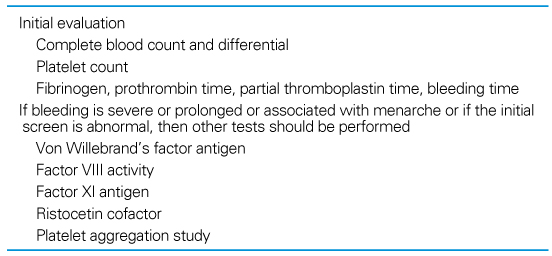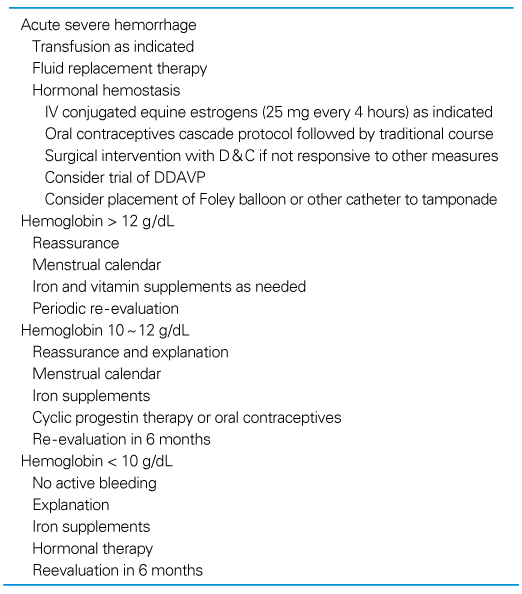 |
 |
- Search
| J Korean Med Assoc > Volume 52(8); 2009 > Article |
Abstract
Abnormal uterine bleeding is a common clinical problem in adolescence but also a potentially difficult condition to treat. Furthermore, most diagnostic criteria and treatment algorithms were optimized for adults and not validated for adolescent population. Abnormal uterine bleeding may be associated with many conditions, including pregnancy, endocrine disorders, chronic diseases and congenital conditions. Using the menstrual cycle as an additional vital sign adds a powerful tool for the isolation of pathological conditions via the assessment of normal development. It is important for clinicians to have an understanding of bleeding patterns of adolescents, the ability to distinguish normal menstruation from abnormal one, and the skill to evaluate the young female patient appropriately. Routine evaluation should include a careful history, physical examination as indicated and permitted, and laboratory studies including a pregnancy test and a complete blood cell count. Quantifying the level of anemia and degree of bleeding along with managing expectations will provide basis for a more successful treatment plan that can almost always avoid surgical methods.
References
1. Livingstone M, Fraser IS. Mechanisms of abnormal uterine bleeding. Hum Reprod Update 2002;Jan-Feb. 8:60-67.
2. Venturoli S, Porcu E, Fabbri R, Magrini O, Gammi L, Paradisi R, Flamigni C. Longitudinal evaluation of the different gonadotropin pulsatile patterns in anovulatory cycles of young girls. J Clin Endocrinol Metab 1992;04. 74:836-841.
3. Vihko R, Apter D. Endocrine characteristics of adolescent menstrual cycles: impact of early menarche. J Steroid Biochem 1984;01. 20:231-236.
4. World Health Organization multicenter study on menstrual and ovulatory patterns in adolescent girls. II. Longitudinal study of menstrual patterns in the early postmenarcheal period, duration of bleeding episodes and menstrual cycles. World Health Organization Task Force on Adolescent Reproductive Health. J Adolesc Health Care 1986;07. 7:236-244.
5. Hickey M, Balen A. Menstrual disorders in adolescence: investigation and management. Hum Reprod Update 2003;Sep-Oct. 9:493-504.
6. Crosignani PG, Rubin B. Dysfunctional uterine bleeding. Hum Reprod 1990;07. 5:637-638.
7. Fraser IS, Pearse C, Shearman RP, Elliott PM, McIlveen J, Markham R. Efficacy of mefenamic acid in patients with a complaint of menorrhagia. Obstet Gynecol 1981;11. 58:543-551.
8. van Eijkeren MA, Scholten PC, Christiaens GC, Alsbach GP, Haspels AA. The alkaline hematin method for measuring menstrual blood loss- a modification and its clinical use in menorrhagia. Eur J Obstet Gynecol Reprod Biol 1986;09. 22:345-351.
9. Liu Z, Doan QV, Blumenthal P, Dubois RW. A systematic review evaluating health-related quality of life, work impairment, and health-care costs and utilization in abnormal uterine bleeding. Value Health 2007;May-Jun. 10:183-194.
10. Friberg B, Orno AK, Lindgren A, Lethagen S. Bleeding disorders among young women: a population-based prevalence study. Acta Obstet Gynecol Scand 2006;85:200-206.
11. Palomba S, Falbo A, Zullo F, Orio F Jr. Evidence-based and potential benefits of metformin in the polycystic ovary syndrome: a comprehensive review. Endocr Rev 2009;02. 30:1-50.
12. Claessens EA, Cowell CA. Acute adolescent menorrhagia. Am J Obstet Gynecol 1981;02. 01. 13:9277-9280.
13. Smith YR, Quint EH, Hertzberg RB. Menorrhagia in adolescents requiring hospitalization. J Pediatr Adolesc Gynecol 1998;02. 11:13-15.
14. ACOG practice bulletin: management of anovulatory bleeding. Int J Gynaecol Obstet 2001;03. 72:263-271.
15. Kulp JL, Mwangi CN, Loveless M. Screening for coagulation disorders in adolescents with abnormal uterine bleeding. J Pediatr Adolesc Gynecol 2008;02. 21:27-30.
16. Dijkhuizen FP, Brolmann HA, Potters AE, Bongers MY, Heinz AP. The accuracy of transvaginal ultrasonography in the diagnosis of endometrial abnormalities. Obstet Gynecol 1996;03. 87:345-349.
17. Breitkopf DM, Frederickson RA, Snyder RR. Detection of benign endometrial masses by endometrial stripe measurement in premenopausal women. Obstet Gynecol 2004;07. 104:120-125.
18. Farhi DC, Nosanchuk J, Silverberg SG. Endometrial adenocarcinoma in women under 25 years of age. Obstet Gynecol 1986;12. 68:741-745.
19. Ferenczy A. Pathophysiology of endometrial bleeding. Maturitas 2003;05. 30. 45:1-14.
20. Toth M, Patton DL, Esquenazi B, Shevchuk M, Thaler H, Divon M. Association between Chlamydia trachomatis and abnormal uterine bleeding. Am J Reprod Immunol 2007;05. 57:361-366.
21. Quint EH, Smith YR. Abnormal uterine bleeding in adolescents. J Midwifery Womens Health 2003;May-Jun. 48:186-191.
22. Falcone T, Desjardins C, Bourque J, Granger L, Hemmings R, Quiros E. Dysfunctional uterine bleeding in adolescents. J Reprod Med 1994;10. 39:761-764.
23. Janssen CA, Scholten PC, Heintz AP. A simple visual assessment technique to discriminate between menorrhagia and normal menstrual blood loss. Obstet Gynecol 1995;06. 85:977-982.
24. Dubinsky T, Abu-Gazzeh Y, Stroehlein K. Role of transvaginal sonography and endometrial biopsy in the evaluation of dysfunctional uterine bleeding in premenopausal women. J Clin Ultrasound 1998;Mar-Apr. 26:180-181.
25. DeVore GR, Owens O, Kase N. Use of intravenous Premarin in the treatment of dysfunctional uterine bleeding- a double-blind randomized control study. Obstet Gynecol 1982;03. 59:285-291.
26. Bowkley CW, Dubel GJ, Haas RA, Soares GM, Ahn SH. Uterine artery embolization for control of life-threatening hemorrhage at menarche: brief report. J Vasc Interv Radiol 2007;01. 18:127-131.
27. Walker WJ, McDowell SJ. Pregnancy after uterine artery embolization for leiomyomata: a series of 56 completed pregnancies. Am J Obstet Gynecol 2006;11. 195:1266-1271.
28. Gerschultz KL, Sucato GS, Hennon TR, Murray PJ, Gold MA. Extended cycling of combined hormonal contraceptives in adolescents: physician views and prescribing practices. J Adolesc Health 2007;02. 40:151-157.
29. Bagwell MA, Thompson SJ, Addy CL, Coker AL, Baker ER. Primary infertility and oral contraceptive steroid use. Fertil Steril 1995;06. 63:1161-1166.
30. Willman EA, Collins WP, Clayton SG. Studies in the involvement of prostaglandins in uterine symptomatology and pathology. Br J Obstet Gynaecol 1976;05. 83:337-341.
31. Smith SK, Abel MH, Kelly RW, Baird DT. Prostaglandin synthesis in the endometrium of women with ovular dysfunctional uterine bleeding. Br J Obstet Gynaecol 1981;04. 88:434-442.
32. Lethaby A, Augood C, Duckitt K, Farquhar C. Nonsteroidal anti-inflammatory drugs for heavy menstrual bleeding. Cochrane Database Syst Rev 2007;CD000400.
33. Irvine GA, Cameron IT. Medical management of dysfunctional uterine bleeding. Baillieres Best Pract Res Clin Obstet Gynaecol 1999;06. 13:189-202.
34. Rydin E, Lundberg PO. Letter: Tranexamic acid and intracranial thrombosis. Lancet 1976;07. 2:49.
35. Agnelli G, Gresele P, De Cunto M, Gallai V, Nenci GG. Tranexamic acid, intrauterine contraceptive devices and fatal cerebral arterial thrombosis. Case report. Br J Obstet Gynaecol 1982;08. 89:681-682.
36. Andersch B, Milsom I, Rybo G. An objective evaluation of flurbiprofen and tranexamic acid in the treatment of idiopathic menorrhagia. Acta Obstet Gynecol Scand 1988;67:645-648.
37. ACOG Committee Opinion No 392 December 2007 Intrauterine device and adolescents. Obstet Gynecol 2007;12. 110:1493-1495.
- TOOLS
-
METRICS

-
- 0 Crossref
- Scopus
- 1,133 View
- 7 Download
-
Related articles in
J Korean Med Assoc -
Pornography and Sex in Adolescents1997 October;40(10)
School Failures and Studying Abroad in Adolescence1997 October;40(10)
Dysfunctional Uterin Bleeding(DUB) in Adolescents1998 July;41(7)
Cognitive and Group Treatment of Internet Addiction in Adolescents2006 March;49(3)












